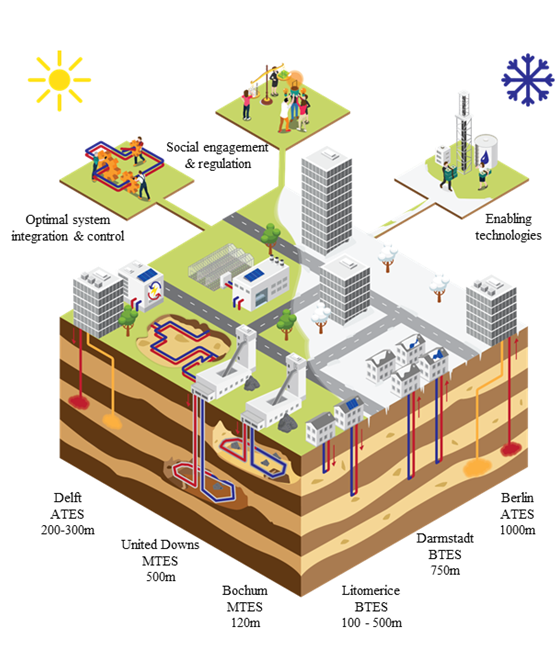PUSH-IT
The EU aims to have a net-zero greenhouse gas (GHG) economy by 2050, with 55% reduction on 1990 levels by 2030. At present, heating and cooling represent around 50% of the final energy demand in Europe and are mainly supplied by fossil fuel derived energy. It is therefore essential for heating and cooling to decarbonise to achieve EU ambitions.
A challenge for decarbonizing heat systems is the size of the seasonal mismatch between demand for heat and heat generation from sustainable sources. One of the main solutions to address this mismatch is to store energy for later use if it is not needed at time of conversion. Optimal utilisation of sustainable heat requires storing large amounts of heat to account for seasonal supply and demand fluctuations. Various technologies have been proposed for large-scale heat storage in geothermal reservoirs and low temperature storage is routinely applied.
The PUSH-IT project (Piloting Underground Seasonal Heat Storage in Geothermal Reservoirs) focuses on extending storage temperature ranges to high temperatures by showcasing three high-temperature heat storage technologies that are fit for a wide variety of geological conditions covering most locations in Europe: Aquifer, Borehole and Mine Thermal Energy Storage (ATES, BTES and MTES). Each of the three technologies will be showcased in two different sites, corresponding to a 'demo' site, ATES in Delft, BTES in Darmstadt and MTES in Bochum, and a 'follower' site in Berlin, Litomerice and Cornwall, respectively.
The heat storage to be demonstrated at the TU Delft is a high-temperature aquifer thermal heat storage (HT-ATES) system in combination with geothermal wells as a source for heat. ATES systems use two or more wells for the injection or extraction of water to carry heat to or from reservoirs or aquifers. The HT-ATES in Delft will store about 60 TJ of surplus heat in the summer, used to supply peaks in winter. The temperature level provided by the geothermal heat source is 78 °C. The ATES system pre-design constitutes seven wells storing heat in an aquifer at 150 to 250 meter depth.
PUSH-IT is an international and interdisciplinary project. It aims to address and include all relevant societal, technological and geologic conditions at our demonstration sites by adopting and applying an inter-and transdisciplinary approach to technology development, innovation and application in society. Amongst the partners are heat network operators, drilling companies, system component developers and academic institutions with expertise across multiple disciplines.
Project Results
The main objective of PUSH-IT is to showcase the full-scale applications of heat storage (up-to 90°C) of three different technologies in geothermal reservoirs at six different sites with various societal, heat network and geologic conditions relevant across Europe. PUSH-IT will implement, develop and test the ability of Mine, Borehole and Aquifer Thermal Energy Storage technologies (MTES, BTES and ATES) to store and recover heat.
Other project objectives and ambitions are:
- Enable joint decision making of citizens, regulators and operators to increase social acceptance;
- Development of enabling technologies to adapt thermal energy storage in mines (MTES), in boreholes (BTES) and in aquifers (ATES) to a wide range of geological conditions;
- Develop an open-source tool to assess and optimise levelised cost of energy (LCOE) reduction and costs of carbon emission reduction;
- Optimised integration in heat systems via co-simulation and machine learning.
In summary, the anticipated results are:
- Demonstration of seasonal heat storage;
- Engaging society and organisation;
- Reducing CO2 emissions and costs;
- Fast track market upscaling.
The project will run from 2023-2027. For questions, please contact the Project leader Dr. Martin Bloemendal j.m.bloemendal@tudelft.nl.
This project is funded European Commission under grant Agreement 101096566

Project Figures
-18 partners- 9 researchers from 1 faculty
- 5 Work packages
- Overall project budget €19.8M
- Grant amount €17.9M
- TUD grant allocation €2.4M
